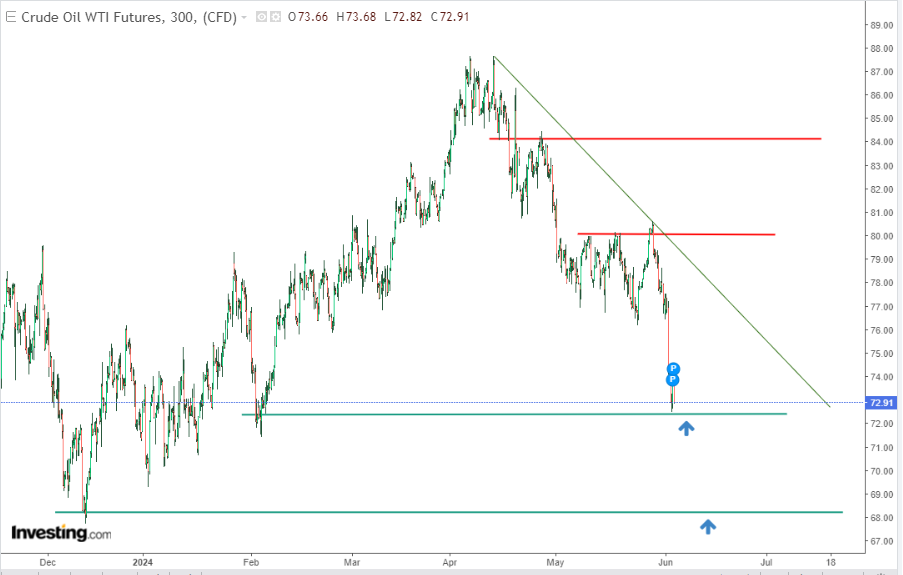- Over the weekend, OPEC+ decided to extend oil production cuts.
- But, oil prices continue to head lower.
- Several factors are weighing on oil prices and WTI is currently targeting the $70 area.
- Invest like the big funds for under $9/month with our AI-powered ProPicks stock selection tool. Learn more here>>
The OPEC+ decided to extend its voluntary oil production cuts by 2.2 million barrels per day until the end of 2025. This positive news, however, failed to halt the decline in oil prices.
Meanwhile, both Brent and WTI crude oil quotations continue to slide due to concerns about the potential abandonment of the cuts by some OPEC+ members down the line.
Geopolitical tensions, including the Gaza conflict, are also losing their grip on oil prices as hopes for de-escalation emerge. This could further dampen demand and give sellers additional leverage.
As a result, the base scenario remains a downward trend for oil prices.
Why Are Oil Prices Slipping Despite Production Cuts?
While the extension of cuts should at least slow the decline, a closer look reveals a potential caveat. The communiqué mentions the possibility of eight cartel members abandoning the cuts as early as October.
This uncertainty is likely fueling the continued downward pressure on prices.
Weak Global Demand Weighing on Oil Prices Too
Beyond the OPEC+ decision, global economic factors also play a role. Record production from Canada, Brazil, and especially the US is expected to significantly increase global oil output next year, according to OPEC+ forecasts.
This additional supply coincides with weakened demand from China and potentially the US due to continued restrictive monetary policy.
A recent indicator of this weaker demand is the 1.4% decrease in US oil demand recorded during the period leading up to Memorial Day compared to the previous year.
Easing Geopolitical Concerns
Typically, a de-escalation of tensions in the Middle East benefits the supply side of oil prices. Signals from the White House about ending the Gaza conflict met with approval from Israel, offer a potential truce.
This could unblock the Red Sea oil shipping route, which has been largely abandoned due to Houthi attacks on merchant ships. However, any potential disruption from this source remains a concern.
WTI Lurks Near Key Support at $72, Eyes $70 Next
The downward movement has pushed WTI crude oil prices near a crucial support zone around $72 per barrel. While a local rebound is possible, the combination of factors favoring the supply side suggests the downward trend is likely to continue.

If prices break below $72, sellers could target this year's lows near $68 but before that, they would need to clear support at $70. However, a significant rebound could see prices test the downtrend line, offering potential short-selling opportunities at higher levels.
This analysis highlights the complex interplay of factors influencing oil prices. While OPEC+ intervention can be a positive influence, other economic and geopolitical forces play a significant role.
The coming weeks will be crucial to see if oil prices can find support or continue their downward trajectory.
***
Become a Pro: Sign up now! CLICK HERE to join the PRO Community with a significant discount.

Disclaimer: This article is written for informational purposes only; it does not constitute a solicitation, offer, advice, counsel or recommendation to invest as such it is not intended to incentivize the purchase of assets in any way. I would like to remind you that any type of asset, is evaluated from multiple perspectives and is highly risky and therefore, any investment decision and the associated risk remains with the investor.
